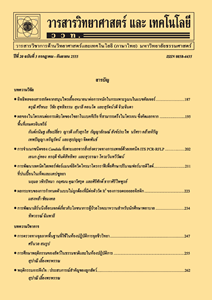Effect of Hydropriming on Quality of Chia (Salvia hispanica L.) Seeds
Main Article Content
Abstract
Chia seed is an excellent source of proteins, omega-3 and fibers. The consumption of chia seed has increased in recent years. Production of chia grains for consumption has to be started from good seed quality. Therefore, the objective of this study was to evaluate the effects of hydropriming on quality of chia seeds. The experiment was designed in completely randomized design that composed of 7 treatments with 4 replications, each replication was contained for 50 seeds: non-primed seeds (control), soaking seed in RO water at 20 or 30ºC for 12, 24 or 36 hours. Seeds were then re-dried until 7 % moisture content. The results showed that hydroprimed seeds at 20 or 30 ºC for 12 hours had the highest germination (88.00 and 84.50 %, respectively), and the fastest mean germination time (3.64 and 3.85 days, respectively), but there were not significantly different with non-primed seed. Furthermore, hydroprimed seeds at 20 or 30 ºC for 24 or 36 hours had pre-germinated during drying, which was not suitable for seed priming.
Article Details
References
Muñoz, L.A., Cobos, A., Diaz, O. and Aguilera, J.M., 2012, Chia seeds: Microstructure, mucilage extraction and hydration, J. Food Eng. 108: 216-224.
Ayerza, R. and Coates, W., 2009, Chia (Salvia hispanica L.) seed as an n-3 fatty acid source for finishing pigs: Effects on fatty acid composition and fat stability of the meat and internal fat, growth performance, and meat sensory characteristics, J. Animal Sci. 87: 3798-3804.
Ayerza, R. and Coates, W., 2011, Protein content, oil content and fatty acid profiles as potential criteria to determine the origin of commercially grown chia (Salvia hispanica L.), Ind. Crop. Prod. 34: 1366-1371.
Alfredo, V.O., Gabriel, R.R., Luis, C.G. and David, B.A., 2009, Physicochemical properties of a fibrous fraction from chia (Salvia hispanica L.), LWT Food Sci. Technol. 42: 168-173.
Ayerza, R. and Coates, W., 2005, Chia: Rediscovering a Forgotten Crop of the Aztecs, University of Arizona Press, Tucson, AZ.
Capitani, M.I., Spotorno, V., Nolasco, S.M. and Tomás, M.C., 2012, Physicochemical and functional characterization of by-products from chia (Salvia hispanica L.), LWT Food Sci. Technol. 45: 94-102.
Bradford, K.J., 1986, Manipulation of seed water relation via osmotic priming to improve germination under stress condition, Hort. Sci. 21: 1105-1112.
McDonald, M.B., 2000, Seed Priming, pp. 287-325, In Bewley, J.D. and Black, M. (Eds.), Seed Technology and its Biological Basic, Sheffield Academic Press, England.
Paiva, E.P., Torres, S.B., Sá, F.V.S., Nogueira, N.W., Freitas, R.M.O. and Leite, M.S., 2016, Light regime and temperature on seed germination in Salvia hispanica L., Acta Sci. 38: 513-519.
Carpenter, W.J., 1989, Salvia splendens seed pregermination and priming for rapid and uniform plant emergence, J. Am. Soc. Hort. Sci. 114: 247-250.
Dutta, P., 2018, Seed Priming: New Vistas and Contemporary Perspectives, pp. 3-22, In Rakhit, A. and Singh, H.B. (Eds.), Advances in Seed Priming, Springer Nature Singapore Pte, Ltd., Singapore.
Inallou, M.M. and Ajorlou, Z., 2011, The use of SAS software for analysis of seedling growth in salvia (Salvia officinalis L.), Res. J. Fish. Hydrobiol. 6: 476-480.
Stefanello, R., Neves, L.A.S., Abbad, M.A.B. and Viana, B.B., 2015, Germination and vigor of chia seeds (Salvia hispanica L.-Lamiaceae) under different temperatures and light conditions, Rev. Bras. Plant. Med. 17: 1182-1186.
Dhillon, N.P.S., 1995, Seed priming of male sterile muskmelon (Cucumis melo L.), Seed Sci. Technol. 23: 881-884.
Ellis, R.H. and Roberts, E.H., 1980, Improved equations for the prediction of seed longevity, Ann. Bot. 45: 13-30.
Dastanpoor, N., Fahimi, H., Shariati, M., Davazdahemami, S. and Hashemi, S.M.M., 2013, Effects of hydropriming on seed germination and seedling growth in sage (Salvia officinalis L.), Afr. J. Biotechnol. 12: 1223-1228.
Ibrahim, N.D., Bhadmus, Z. and Singh, A., 2013, Hydro-priming and re-drying effects on germination, emergence and growth of upland rice (Oryza sativa L.), Nig. J. Basic Appl. Sci. 21: 157-164.
Chanprasert, W., 2010, Seed Physiology, Extension and Training Office Press, Kasetsart University, Bangkok, 167 p. (in Thai)
Yan, M., 2016, Hydro-priming increases seed germination and early seedling growth in two cultivars of Napa cabbage (Brassica rapa subsp. pekinensis) grown under salt stress, J. Hort. Sci. Biotech. 91: 421-426.


